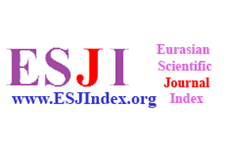Comparative analysis of the formation of liquid reserves in the banking systems of Australia, Czech Republic, Sweden, USA and Indonesia
Inna Viadrova
Department of Banking Business and Financial Technologies, Educational and Scientific Institute «Karazin Banking Institute», V.N. Karazin Kharkiv National University, Ukraine
Olha Bilovska
Department of International E-commerce and Hotel and Restaurant Business, V.N. Karazin Kharkiv National University, Ukraine
Samer Mehyar
Head of project and assets accounts at the Jordan Petroleum Refinery, Amman, Jordan
##semicolon## Lending, Comparative analysis, Liquid reserves, Banking system, Banking performance indicators, Financial flows
सार
Banking activities are constantly in the focus of scientific research. Attention is paid to various aspects of such activities, where one aspect of such attention is the analysis of the dynamics of liquid reserves of the banking system. For these purposes, the work examines statistical data from different banking systems. A comparative analysis of the dynamics of the volume of liquid reserves and the dynamics of the volume of non-performing loans was carried out. Certain aspects of comparative analysis of source data for different banking systems are also considered. Various statistical methods were used to carry out the analysis. The results are presented in the form of separate graphs and diagrams. This helps to understand the progress of the study and evaluate the results obtained.
##submission.citations##
Nazir, M. R., Tan, Y., & Nazir, M. I. (2021). Financial innovation and economic growth: Empirical evidence from China, India and Pakistan. International Journal of Finance & Economics, 26(4), 6036-6059.
Khan, M. A., Siddique, A., & Sarwar, Z. (2020). Determinants of non-performing loans in the banking sector in developing state. Asian Journal of Accounting Research, 5(1), 135-145.
Kuzemin, A., & Lyashenko, V. (2008). Analysis of Spatial-temporal Dynamics in the System of Economic Security of Different Subjects of Economic Management. International Journal Information Technologies and Knowledge, 2(3), 234–238.
Kuzemin, A., & et al.. (2005). Analysis of movement of financial flows of economical agents as the basis for designing the system of economical security (general conception). In Third international conference «Information research, applications, and education (pp. 27-30).
Азаренкова, Г., & Ляшенко, В. (2009). Відношення переваг у порівняльній оцінці діяльності банків. Банківська справа, 5, 65-72.
Lyashenko, V. (2014). Efficiency of bank crediting of real sector of economy in the context of separate banking groups: an empirical example from Ukraine. International Journal of Accounting and Economics Studies, 2(2), 74-79.
Strahan, P. (2008). Liquidity production in 21st century banking (No. w13798). National Bureau of Economic Research.
Alger, G., & Alger, I. (1999). Liquid assets in banks: Theory and practice. GREMAQ, Universite des Sciences Sociales.
Nawaz, T., Haniffa, R., & Hudaib, M. (2021). On intellectual capital efficiency and shariah governance in Islamic banking business model. International Journal of Finance & Economics, 26(3), 3770-3787.
Ляшенко В. В. (2007). Интерпретация и анализ статистических данных, описывающих процессы экономической динамики. Бизнес Информ, 9(2), 108-113.
Kuzemin, A., & Lyashenko, V. (2009). Methods of comparative analysis of banks functioning: classic and new approaches. Information Theories & Applications, 16(4), 384-396.
Куштим, В. В., & Ляшенко, В. В. (2007). Динаміка розвитку банківського сегмента міжнародного фінансового ринку. Фінанси України, (12), 96-105.
Kuzemin, A., & Lyashenko, V. (2006). Fuzzy set theory approach as the basis of analysis of financial flows in the economical security system. International Journal Information Theories & Applications, 13(1), 45-51.
Baranova, V., Zeleniy, O., Deineko, Z., & Lyashenko, V. (2019, October). Stochastic Frontier Analysis and Wavelet Ideology in the Study of Emergence of Threats in the Financial Markets. In 2019 IEEE International Scientific-Practical Conference Problems of Infocommunications, Science and Technology (PIC S&T) (pp. 341-344). IEEE.
Kuzemin, A., & Lyashenko V. (2011). Microsituation Concept in GMES Decision Support Systems. In Intelligent Data Processing in Global Monitoring for Environment and Security, 217–238.
Lyashenko, V. V., Matarneh, R., Baranova, V., & Deineko, Z. V. (2016). Hurst Exponent as a Part of Wavelet Decomposition Coefficients to Measure Long-term Memory Time Series Based on Multiresolution Analysis. American Journal of Systems and Software, 4(2), 51-56.
Omarov, M., Tikhaya, T., & Lyashenko, V. (2019). Internet marketing metrics visualization methodology for related search queries. International Journal of Advanced Trends in Computer Science and Engineering, 8(5), 2277-2281.
Lyashenko, V., Deineko, Z., & Ahmad, A. (2015). Properties of Wavelet Coefficients of Self-Similar Time Series. International Journal of Scientific and Engineering Research, 6, 1492-1499.
Tvoroshenko, I., Ahmad, M. A., Mustafa, S. K., Lyashenko, V., & Alharbi, A. R. (2020). Modification of models intensive development ontologies by fuzzy logic. International Journal of Emerging Trends in Engineering Research, 8(3), 939-944.
Dadkhah, M., Lyashenko, V. V., Deineko, Z. V., Shamshirband, S., & Jazi, M. D. (2019). Methodology of wavelet analysis in research of dynamics of phishing attacks. International Journal of Advanced Intelligence Paradigms, 12(3-4), 220-238.
Vasiurenko, O., Lyashenko, V., Baranova, V., & Deineko, Z. (2020). Spatial-Temporal Analysis the Dynamics of Changes on the Foreign Exchange Market: an Empirical Estimates from Ukraine. Journal of Asian Multicultural Research for Economy and Management Study, 1(2), 1-6.
Dadkhah, M., Lyashenko, V., & Jazi, M. (2015). Methodology of the Chaos Theory in research of phishing attacks. International Journal of Academic Research, 7(1), 169-175.
Mousavi, S. M. H., Victorovich, L. V., Ilanloo, A., & Mirinezhad, S. Y. (2022, November). Fatty Liver Level Recognition Using Particle Swarm optimization (PSO) Image Segmentation and Analysis. In 2022 12th International Conference on Computer and Knowledge Engineering (ICCKE) (pp. 237-245). IEEE.
Lyashenko, V., Zeleniy, O., Mustafa, S. K., & Ahmad, M. A. (2019). An advanced methodology for visualization of changes in the properties of a dye. International Journal of Engineering and Advanced Technology, 9(1), 711-7114.
Shrestha, P. K. (2013). Banking systems, central banks and international reserve accumulation in East Asian economies. Economics, 7(1), 20130014.
Arif, A., & Nauman Anees, A. (2012). Liquidity risk and performance of banking system. Journal of Financial regulation and compliance, 20(2), 182-195.
Alper, K., Binici, M., Demiralp, S., Kara, H., & Özlü, P. (2018). Reserve requirements, liquidity risk, and bank lending behavior. Journal of Money, Credit and Banking, 50(4), 817-827.
Riahi, Y. M. (2019). How to explain the liquidity risk by the dynamics of discretionary loan loss provisions and non-performing loans? The impact of the global crisis. Managerial Finance, 45(2), 244-262.
Messai, A. S., & Jouini, F. (2013). Micro and macro determinants of non-performing loans. International journal of economics and financial issues, 3(4), 852-860.
Chimkono, E. E., Muturi, W., & Njeru, A. (2016). Effect of non-performing loans and other factors on performance of commercial banks in Malawi. International Journal of Economics, Commerce and Management, 4(2), 549-563.
Orhan, A., Kirikkaleli, D., & Ayhan, F. (2019). Analysis of wavelet coherence: service sector index and economic growth in an emerging market. Sustainability, 11(23), 6684.
Kirikkaleli, D., & Gokmenoglu, K. K. (2020). Sovereign credit risk and economic risk in Turkey: empirical evidence from a wavelet coherence approach. Borsa Istanbul Review, 20(2), 144-152.
Wang, Y., Wei, M., Bashir, U., & Zhou, C. (2022). Geopolitical risk, economic policy uncertainty and global oil price volatility—an empirical study based on quantile causality nonparametric test and wavelet coherence. Energy Strategy Reviews, 41, 100851.
Vasiurenko, O., & Lyashenko, V. (2020). Wavelet coherence as a tool for retrospective analysis of bank activities. Economy and Forecasting, (2), 43-60.
Baranova, V., Orlenko, O., Vitiuk, A., Yakimenko-Tereschenko, N., & Lyashenko, V. (2020). Information system for decision support in the field of tourism based on the use of spatio-temporal data analysis. International Journal of Advanced Trends in Computer Science and Engineering, 9(4), 6356-6361.

















